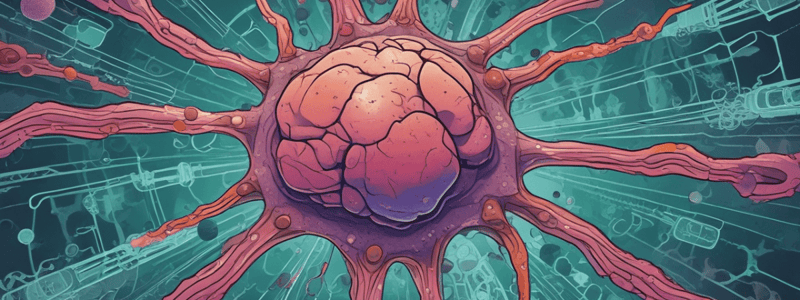Podcast
Questions and Answers
What type of radiation has a short wavelength?
What type of radiation has a short wavelength?
- Ultraviolet waves
- Gamma waves (correct)
- Beta particles
- Alpha particles
What is the unit of measurement for biological damage caused by radiation?
What is the unit of measurement for biological damage caused by radiation?
- Sieverts (correct)
- Linear Energy Transfer
- Electromagnetic Waves
- Gamma Rays
What type of radiation produces more double-strand breaks leading to translocations and deletions?
What type of radiation produces more double-strand breaks leading to translocations and deletions?
- Ionising radiation
- Low LET radiation
- High LET radiation (correct)
- Ultraviolet radiation
What is the term for the rate at which a radiation source releases energy?
What is the term for the rate at which a radiation source releases energy?
What is the composition of an alpha particle?
What is the composition of an alpha particle?
What is the issue with radiation, in terms of DNA damage?
What is the issue with radiation, in terms of DNA damage?
What is the mechanism by which Rous Sarcoma virus causes oncogenicity?
What is the mechanism by which Rous Sarcoma virus causes oncogenicity?
What is the result of the HPV E6 protein binding to the p53 protein?
What is the result of the HPV E6 protein binding to the p53 protein?
Which virus is associated with Burkitt's lymphoma and nasopharyngeal carcinoma?
Which virus is associated with Burkitt's lymphoma and nasopharyngeal carcinoma?
What is the mechanism by which Helicobacter pylori causes carcinogenesis?
What is the mechanism by which Helicobacter pylori causes carcinogenesis?
What is the result of the HTLV tax protein?
What is the result of the HTLV tax protein?
What is the result of mistakes in DNA repair during the immune response to Hepatitis B Virus?
What is the result of mistakes in DNA repair during the immune response to Hepatitis B Virus?
What is the role of tumour suppressor proteins in the body?
What is the role of tumour suppressor proteins in the body?
What is the term for the loss of one allele and the subsequent inactivation of the other wild-type allele?
What is the term for the loss of one allele and the subsequent inactivation of the other wild-type allele?
What is the result of the oxidative respiration and lipid peroxidation in the cell?
What is the result of the oxidative respiration and lipid peroxidation in the cell?
What is the frequency of DNA damage in a cell per day?
What is the frequency of DNA damage in a cell per day?
What is the primary effect of ionising radiation on DNA?
What is the primary effect of ionising radiation on DNA?
What is the resulting mutation when 8-oxo-guanine is incorrectly paired with adenine during DNA synthesis?
What is the resulting mutation when 8-oxo-guanine is incorrectly paired with adenine during DNA synthesis?
What is the commonest type of UV-induced mutation in skin cancer?
What is the commonest type of UV-induced mutation in skin cancer?
What is the result of failure in DNA repair after exposure to high levels of UV radiation?
What is the result of failure in DNA repair after exposure to high levels of UV radiation?
What is the primary mechanism of action of chemical carcinogens?
What is the primary mechanism of action of chemical carcinogens?
What is the function of cytochrome P450 enzymes in chemical carcinogenesis?
What is the function of cytochrome P450 enzymes in chemical carcinogenesis?
What is the primary carcinogenic compound in cigarette smoke?
What is the primary carcinogenic compound in cigarette smoke?
What is the result of alkylation of the O6 position of guanine?
What is the result of alkylation of the O6 position of guanine?
What is the primary mechanism of action of DNA tumour viruses?
What is the primary mechanism of action of DNA tumour viruses?
What is the type of virus that causes Burkitt’s lymphoma?
What is the type of virus that causes Burkitt’s lymphoma?
What is the primary function of the retinoblastoma protein at the G1 checkpoint?
What is the primary function of the retinoblastoma protein at the G1 checkpoint?
Which type of mutation is often seen in inherited retinoblastoma, leading to the duplication of identical mutations?
Which type of mutation is often seen in inherited retinoblastoma, leading to the duplication of identical mutations?
What is the consequence of phosphorylation of the retinoblastoma protein?
What is the consequence of phosphorylation of the retinoblastoma protein?
What is the typical age of onset for retinoblastoma tumors in individuals with germline mutations?
What is the typical age of onset for retinoblastoma tumors in individuals with germline mutations?
What is the role of the cyclin D/Cdk4 complex in the cell cycle?
What is the role of the cyclin D/Cdk4 complex in the cell cycle?
What is the term for genes that, when mutated, predispose individuals to cancer?
What is the term for genes that, when mutated, predispose individuals to cancer?
Flashcards
What type of radiation has a short wavelength?
What type of radiation has a short wavelength?
Gamma rays are a type of electromagnetic radiation with very short wavelengths and high energy, making them highly penetrating.
What is the unit of measurement for biological damage caused by radiation?
What is the unit of measurement for biological damage caused by radiation?
Sieverts (Sv) are the units used to measure the biological damage caused by radiation exposure, factoring in both the type of radiation and its energy.
What type of radiation produces more double-strand breaks in DNA?
What type of radiation produces more double-strand breaks in DNA?
High LET radiation, like alpha particles, deposits energy densely along its path, causing more double-strand breaks in DNA. This leads to more complex DNA damage, including translocations and deletions.
What is the term for the rate at which a radiation source releases energy?
What is the term for the rate at which a radiation source releases energy?
Signup and view all the flashcards
What is the composition of an alpha particle?
What is the composition of an alpha particle?
Signup and view all the flashcards
What is the issue with radiation, in terms of DNA damage?
What is the issue with radiation, in terms of DNA damage?
Signup and view all the flashcards
How does Rous Sarcoma virus cause oncogenicity?
How does Rous Sarcoma virus cause oncogenicity?
Signup and view all the flashcards
What is the result of HPV E6 protein binding to the p53 protein?
What is the result of HPV E6 protein binding to the p53 protein?
Signup and view all the flashcards
Which virus is associated with Burkitt's lymphoma and nasopharyngeal carcinoma?
Which virus is associated with Burkitt's lymphoma and nasopharyngeal carcinoma?
Signup and view all the flashcards
What is the mechanism by which Helicobacter pylori causes carcinogenesis?
What is the mechanism by which Helicobacter pylori causes carcinogenesis?
Signup and view all the flashcards
What is the result of the HTLV tax protein?
What is the result of the HTLV tax protein?
Signup and view all the flashcards
What is the result of mistakes in DNA repair during the immune response to Hepatitis B Virus?
What is the result of mistakes in DNA repair during the immune response to Hepatitis B Virus?
Signup and view all the flashcards
What is the role of tumor suppressor proteins in the body?
What is the role of tumor suppressor proteins in the body?
Signup and view all the flashcards
What is the term for the loss of one allele and the subsequent inactivation of the other wild-type allele?
What is the term for the loss of one allele and the subsequent inactivation of the other wild-type allele?
Signup and view all the flashcards
What is the result of oxidative respiration and lipid peroxidation in the cell?
What is the result of oxidative respiration and lipid peroxidation in the cell?
Signup and view all the flashcards
What is the frequency of DNA damage in a cell per day?
What is the frequency of DNA damage in a cell per day?
Signup and view all the flashcards
What is the primary effect of ionizing radiation on DNA?
What is the primary effect of ionizing radiation on DNA?
Signup and view all the flashcards
What resulting mutation occurs when 8-oxo-guanine is incorrectly paired with adenine during DNA synthesis?
What resulting mutation occurs when 8-oxo-guanine is incorrectly paired with adenine during DNA synthesis?
Signup and view all the flashcards
What is the commonest type of UV-induced mutation in skin cancer?
What is the commonest type of UV-induced mutation in skin cancer?
Signup and view all the flashcards
What is the result of failure in DNA repair after exposure to high levels of UV radiation?
What is the result of failure in DNA repair after exposure to high levels of UV radiation?
Signup and view all the flashcards
What is the primary mechanism of action of chemical carcinogens?
What is the primary mechanism of action of chemical carcinogens?
Signup and view all the flashcards
What is the function of cytochrome P450 enzymes in chemical carcinogenesis?
What is the function of cytochrome P450 enzymes in chemical carcinogenesis?
Signup and view all the flashcards
What is the primary carcinogenic compound in cigarette smoke?
What is the primary carcinogenic compound in cigarette smoke?
Signup and view all the flashcards
What is the result of alkylation of the O6 position of guanine?
What is the result of alkylation of the O6 position of guanine?
Signup and view all the flashcards
What is the primary mechanism of action of DNA tumor viruses?
What is the primary mechanism of action of DNA tumor viruses?
Signup and view all the flashcards
What is the type of virus that causes Burkitt's lymphoma?
What is the type of virus that causes Burkitt's lymphoma?
Signup and view all the flashcards
What is the primary function of the retinoblastoma protein at the G1 checkpoint?
What is the primary function of the retinoblastoma protein at the G1 checkpoint?
Signup and view all the flashcards
Which type of mutation is often seen in inherited retinoblastoma, leading to the duplication of identical mutations?
Which type of mutation is often seen in inherited retinoblastoma, leading to the duplication of identical mutations?
Signup and view all the flashcards
What is the consequence of phosphorylation of the retinoblastoma protein?
What is the consequence of phosphorylation of the retinoblastoma protein?
Signup and view all the flashcards
What is the typical age of onset for retinoblastoma tumors in individuals with germline mutations?
What is the typical age of onset for retinoblastoma tumors in individuals with germline mutations?
Signup and view all the flashcards
What is the role of the cyclin D/Cdk4 complex in the cell cycle?
What is the role of the cyclin D/Cdk4 complex in the cell cycle?
Signup and view all the flashcards
What is the term for genes that, when mutated, predispose individuals to cancer?
What is the term for genes that, when mutated, predispose individuals to cancer?
Signup and view all the flashcards



